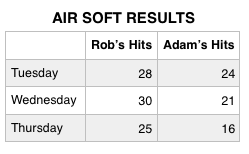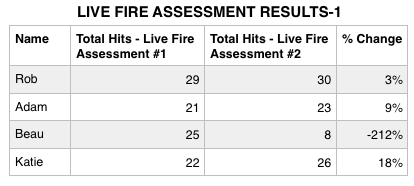By Rob Shaul
The staff at Mountain Tactical recently completed a “Mini Study” to assess the affects airsoft target has on actual marksmanship. A follow up to our Dry Fire Mini Study a earlier this winter, we were hoping working with airsoft rifles, indoors, and getting actual target shot placement feedback, would transfer to the range. We saw some improvement, but not enough to show any real traction.
Why an Airsoft Study?
The results from our Trigger Pull Study last December were statistically inconclusive because some of the individual Fresno part-time SWAT team members we used as lab rats had widely variable marksmanship results between the first and second trial. The team members get together to train either one day, or two days/month, and have to work in that training time all their training requirements – including marksmanship.
We felt one possible reason for the inconsistent shooting was simply that the team members didn’t get much time on the range with their long rifles. Most SWAT teams are part-time, and we reasoned this was a common issue.
As well, we know on the military side, many line units are lucky to get to the range once per quarter.
Recommending tactical athletes spend more time at the range is an obvious recommendation, but doesn’t reflect the realities for most of of available training time, range access, ammunition, etc.
So, is there a way we can improve marksmanship without actual range time? Finding and validating an efficient, cheap, safe and effective, non-live fire methodology to improve marksmanship would be a great “mission-direct” tool for military and LE athletes everywhere.
Two low cost options present themselves: dry fire work and cheap airsoft target practice.
We began with dry fire work, found nothing promising, and this time, moved to airsoft.
What is a Mini Study?
A small, quick mini study is a great tool for us to accomplish several things before conducting a larger, longer, more involved study.
First, we test the practicality and “churn” the testing protocols in the study. Specifically in the case of dry fire and airsoft – the exact protocols uses for each.
Second, mini study results can often help us quickly identify obvious paths to follow with further research. They can, but don’t always – and didn’t in this case – or the dry fire mini study we conducted previously. I’ll go into details below.
Study Methodology, Assumptions and Hypothesis
Lab Rats & Groups
Three of use served as “lab rats.” Myself and our Director of Research, Adam, served as the “Study Group.” We conducted the indoor airsoft target practice between live fire assessments at the range.
Katie, our Marketing & Operations Lead, and Beau, who works in Business Development served as the “Control Group.”
I’m the most experienced marksman on the staff – largely because of all the range fitness work I’ve done over the years. Beau, Adam and Katie have shot AR’s, but don’t frequently, and thus are somewhat similar to military and LE athletes who rarely get range time.
Assess, Treatments, Re-Assess
Both the Study and Control Groups began the study with a live-fire marksmanship assessment at the range. We did this on Monday and used the same exact live fire range assessment we used for the dry fire mini study. (Scroll down for details and video.)
Next, the “Study Group” (Adam and I) completed 3x air soft rifle “treatments” in the office. We completed a 15-20 minute protocol Tuesday, Wednesday and Thursday. (Scroll down for details and video.)
Friday morning, all four of us returned to the range and re-assessed using the same exact protocol as Monday’s initial live-fire assessment.
Airsoft Set Up
Battery operated, high end airsoft rifles can reach prices into the hundreds of dollars. These can be purchased in nearly exact replicas of actual service rifles.
A set up like that could be ideal, but also expensive, and perhaps cost and hassle-prohibitive for many tactical teams having trouble getting time and funding for live fire practice.
So we went cheap, and purchased a spring-loaded airsoft rifle for under $40. Specifically, we used the Marines Airsoft SR01 Spring Powered Rifle by Crosman, purchased for around $35.
We actually mounted a red dot site on the air soft rifle – to even more closely mirror what we used at the range. Cheap airsoft red dots begin at around $20. We specifically used the Bushnell Trophy TRS-25 Red Dot Sight Riflescope, 1 x 25mm. This unit is more expensive, around $85. I conveniently had one of these already, which I used on a .22 rifle.
For a target, we used a Crosman AirSoft Sticky Target ($15). This target worked well – when hit with the airsoft pellet, the pellet sticks …. which allows us to mark hits, prevents ricochet and an office with pellets all over. On the target, we drew a 2.5” circle around the center bullseye – and used it at a hit/no hit for the recording purposes.
These spring-loaded airsoft rifles are surprisingly accurate. Every once in a while a pellet will have a mind of its own, but overwhelmingly, shots hit where we aimed. It sighted in the rifle using the red dot and achieved about a 1.5” group.
Adam and I recorded our total hits for each of the three days we shot the airsoft rifle – which are below. No consistency with my shooting. Adam’s hits declined each day …. not sure why.

Assumptions & Hypothesis
Again, as with the dry fire mini study, I assumed each of us would improve on the second assessment regardless, simply because we were familiar with the assessment and had shot earlier in the week.
I hypothesized both my and Adam’s improvement on the second assessment would be greater than Katie and Beau’s because we had completed the airsoft practice, and they hadn’t.
If the results showed this hypothesis had promise, this would point to airsoft target practice as a possible tool to improve marksmanship.
Results
Contrary to my hypothesis, Katie (control group) again improved on the assessments (18% combines) much greater than Adam and I (study group), though she didn’t not complete the airsoft target practice.
I actually declined marksmanship performance on the Non-Stress re-assessment (-28%), but did improve significantly on the Stress assessment by 45%. Overall, however, I improved by just 3% – compared to Katie’s 18% improvement.
Adam also improved – 9% overall – but still half of what Katie shot.
Beau (control group) shot very inconsistently – both he and I used a different rifle than the first assessment, and while this didn’t affect me – it could explain his overall drop in performance by over 200%! His inconsistency is an indication we should disregard his results.

Discussion
What happened? Again, not sure…
It could be that airsoft target practice doesn’t improve marksmanship.
It could be our airsoft target practice protocol is flawed.
It could be the study was not long enough and the study group needed more airsoft “treatments” for the effects to show up in the assessment results.
It could be we simply had too few lab rats, and greater numbers would have led to more conclusive results.
Where to Now?
Next we’ll do a similar Mini Study combining dry-fire practice with airsoft rifle target practice in the office. Perhaps combining the two will transfer to better live-fire performance. Again – we’re not looking for definitive “proof” here – but “traction” – which points us in the right direction for more intense study.
Questions/Comments/Feedback?/Want to Help?
rob@mtntactical.com
Please See below for the Specific Assessment and Dry Fire Protocols
Live Fire Assessment Protocol
Target: 8” Metal
Distance: 80 Yards (10 MOA)
Shooting Positions: Unsupported Standing and Kneeling
Warm Up:
a) 2 Times Through
3x Ready Up to Standing
b) 2 Times Through
3x Read Up to Kneeling
c) 1 Magazine, 8x Live Rounds
2 Times Through – No Time Limit
2x Shots Standing
2x Shots Kneeling
Non-Stress Assessment
4 Times Through (24x Shots Total)
Load: 1 Magazine, 6x Live Rounds
Time Limit: None
Target: 8” Metal
Distance: 80 Yards (10 MOA)
Protocol:
On “Commence Fire”
3x Shots Standing
3x Shots Kneeling
Record Total Hits
Stress Assessment
4 Times Through (24x Shots Total)
Load: 1 Magazine, 6x Live Rounds
Time Limit: 15 Seconds
Target: 8” Metal
Distance: 80 Yards (10 MOA)
Protocol:
On “Commence Fire”
3x Shots Standing
3x Shots Kneeling
Record Total Hits made within Time Limit
Airsoft Rifle Protocol
2x Athletes, 1x Weapon
Target: Cheap “gel” target, 1.5” Diameter Bullseye
Distance: Approx. 25 Feet
Time: 15-20 Minutes total
Overall Trigger Pulls: 36x
Non Stress – No Time Limit
On “Commence Fire”
3 Times Through
3x Shots Standing
3x Shots Kneeling
Stress – 20 Second Time Limit
3 Times Through
3x Shots Standing
3x Shots Kneeling
